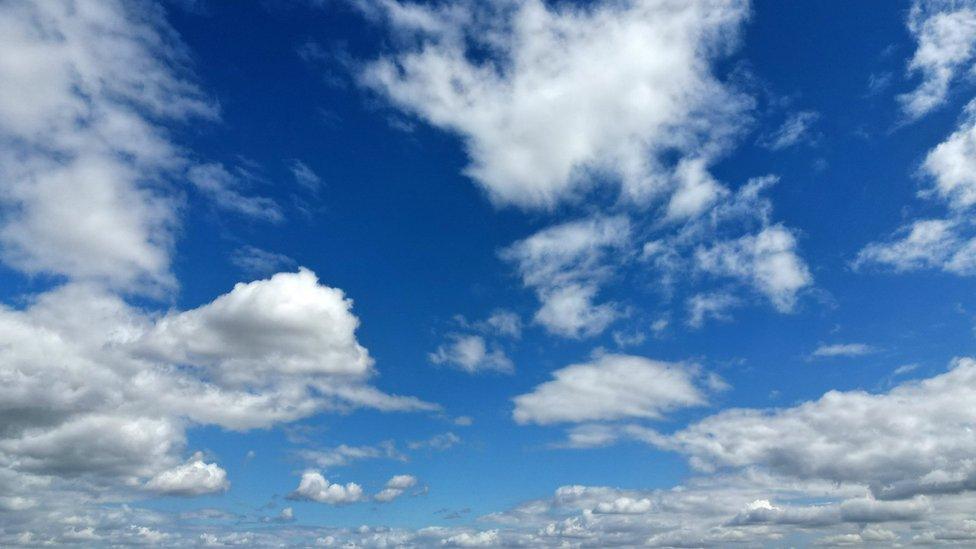The Cloud: Is it bad for the environment?
- Published
- comments

What is The Cloud and could it be damaging the planet?
Whenever you search for something online, scroll on social media or improve your score on an online game you're using something nicknamed The Cloud.
No, we don't mean something white, fluffy and filled with rain!
Cloud computing is when you use something which is saved on the internet - instead of stored directly on your phone, tablet or computer.
In the last few years it's become very popular, but some people are worried about how much energy it uses and how good it is for the environment.
Internet searches results
Online gaming accounts
Everything you see on social media!
Video streaming like YouTube, Netflix, iPlayer etc
The Cloud looks like this - banks of computer servers in a data centre
Where is The Cloud?
If you buy a CD, a DVD or Blu-Ray or a video game on a disc, it's easy to understand where the music, film or game is.
If you stream your music, watch a video on social media or play something online it's less obvious where it's stored.
It's stored in The Cloud - but where is that? It's saved in places called data centres which are all over the world.
Data centres are enormous - each have hundreds or thousands of computers with data saved on them - and they have to stay switched on 24 hours a day.
Because of this, data centres use lots of electricity.
What are the advantages and disadvantages of The Cloud?
The Cloud uses a lot of electricity
Because The Cloud is always turned on, it uses an enormous amount of energy every day.
For example, Google - the biggest search engine on the internet - says every time you search for something it uses as much energy as it takes to light a lightbulb for just under two minutes (108 seconds).
Google processes over 8.5 billion searches every day - which means it's using enough energy to power one light bulb for 29,000 years - every day!
But the company also argues it uses renewable energy to do this and has tree planting programmes to make up for the carbon dioxide released into the air from the energy it needs.
Carbon dioxide or C02 is a greenhouse gas which forms a layer around the Earth's atmosphere.
Heat from the Sun enters the atmosphere but is then trapped by this layer of gases.
This increases the Earth's temperature - also known as global warming.
Microsoft (who make Xbox and Windows Computers) claim The Cloud is more environmentally friendly than using materials to make discs - like DVDs - or other physical formats and transport them around the world.
And Amazon Web Services, one of the biggest owners of cloud servers in the world, says having big data centres is more efficient than having lots of smaller, lower quality data centres in each office or school.
The Cloud has so many uses but the more we upload to social media, and the more information we save there, the more data centres we need and therefore more energy.
Some scientists are worried that we're saving too much on The Cloud, and not deleting much at all.
Everything we upload to the internet stays there forever - even if it's not been seen in a long time.
Professor Gordon Blair, an Environmental Data Scientist at Lancaster University, says there's a "danger that we just keep everything. Absolutely everything is stored these days on the off chance it might be useful..."
"This data is just building up and building up," he says, "We can't just keep doing this forever - we know where it's heading and it's not good."
Why does The Cloud use so much water?
Normal clouds are made up of steam and water droplets - but Cloud computing takes a lot of water to make sure it works properly.
If you've ever tried playing a really new game on an old phone, tablet or games console sometimes that computer struggles to cope and starts getting warm.
That also happens with the computers that make The Cloud work - so cold water is pumped through pipes in the system to cool it.
Some systems reuse the water as many times as they can, but eventually it gets flushed or evaporates into the air.
In some areas where it's very hot, and droughts can be common, people are worried about their water supply being used to cool down computers and the damage this is doing to wildlife and the planet.
Arizona in the US is one such place and Vice Mayor of Mesa, Jenn Duff says some data centres there use up to a 1.75m gallons of water every day - enough to fill two Olympic swimming pools!
Teal Lehto campaigns about water issues in Arizona on TikTok.
Teal Lehto uses TikTok to raise awareness of water supply issues in Arizona using the nickname WesternWaterGirl.
"It's really terrifying to see how far water levels have gone down. I think that we need to instil an ethic of water conservation in every industry," she says.
"Every industry, including The Cloud, needs to be focused on water conservation if they're going to be operating in one of the most arid regions of the United States."
The future of The Cloud
The Cloud allows us quick access to information, thousands of films, songs, stories and games at the press of a button, rather than stored on discs or hard-drives sent around the world.
But some scientists warn against this ever-growing accumulation of data - more and more data means using more and more energy and water - which is they say is not sustainable for our planet.
